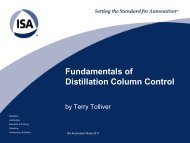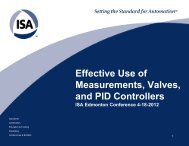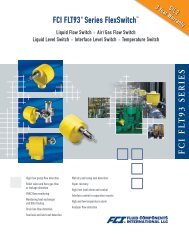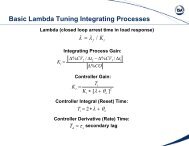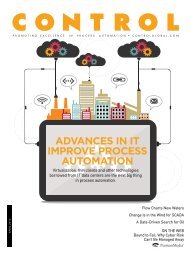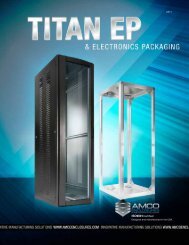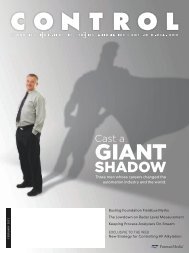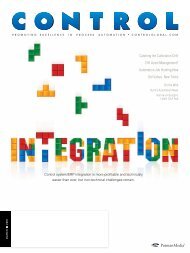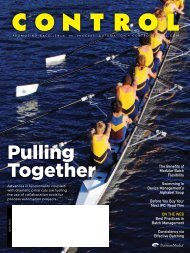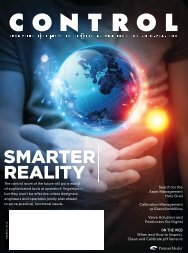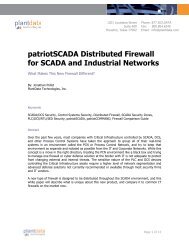April 2011 - Control Global
April 2011 - Control Global
April 2011 - Control Global
Create successful ePaper yourself
Turn your PDF publications into a flip-book with our unique Google optimized e-Paper software.
C o n t r o l E x c l u s i v e<br />
FDT and OPC Collaborate on FDT 2 Standard<br />
The joint FDT and OPC Foundation FDT OPC UA Working Group will develop an OPC UA information model for<br />
the major upgrade to the current FDT standard that is now in preparation. The new version, described by Glenn<br />
B. Schulz, the managing director of the FDT Group, as a “major update” to the current Version 1.2.1, will be released<br />
by the end of this year.<br />
The FDT Group is an open, independent, not-for-profit association of<br />
international companies dedicated to<br />
establishing the FDT Technology as<br />
an international standard with broad<br />
acceptance in the automation industry.<br />
FDT standardizes the communication<br />
and configuration interface<br />
between all field devices and host systems<br />
and provides a common environment<br />
for accessing the devices’ most<br />
sophisticated features.<br />
The OPC Foundation defines standards<br />
for online data exchange between<br />
automation systems. The OPC<br />
Unified Architecture (OPC UA) unifies<br />
the existing standards and brings<br />
them to state-of-the-art technology<br />
using service-oriented architecture<br />
(SOA). OPC UA can run on Windows-based<br />
PC systems., embedded systems and Linux/<br />
UNIX-based enterprise systems.<br />
“This is a unique opportunity to take the best-of-breed<br />
data and information models for the applications and devices<br />
supported by the FDT architecture and leverage the<br />
OPC Unified Architecture (UA) information modeling and<br />
corresponding services for complete application-to-device<br />
integration,” says Thomas J. Burke, president and executive<br />
director of the OPC Foundation. “This exemplifies the<br />
device-to-cloud computing strategy that supports configuration,<br />
communication, run-time and historical data access,<br />
and alarming and event services for existing and upcoming<br />
devices supported through FDT Group technology.”<br />
Schulz adds, “We were looking for a good way to bring devices<br />
together to get information throughout the enterprise.<br />
Now we have two great platforms that enable getting data<br />
across the enterprise, and we are making them interoperable.<br />
We are seamlessly integrating FDT and OPC.”<br />
The implicit and explicit information model specified by<br />
FDT will be defined in a UA companion specification using<br />
OPC UA constructs for the purpose of sending FDT data<br />
to external applications. Further enhancements will be supportable<br />
due to modular construction.<br />
Ready by Year’s End<br />
The Working Group wants to get the<br />
technology out as quickly as possible.<br />
They plan to have a deliverable<br />
product ready by the end of the year.<br />
“Technology changes very quickly,”<br />
says Burke. “We want to take every<br />
step to foster the rapid and wide adoption<br />
of OPC UA/FDT as a standard.”<br />
Another goal is to provide for incremental<br />
adoption. The cooperation<br />
between FDT and OPC will simplify<br />
the technical challenges for end users.<br />
A clear migration path will exist<br />
for legacy equipment or that which<br />
conforms to earlier standards.<br />
“We anticipate many new applications<br />
and places not currently served<br />
by OPC or UA also will be able to take advantage of this<br />
unique collaboration. This strategy of incremental adoption<br />
facilitates easy and simplified deployment into real products<br />
and solutions,” says Burke.<br />
The group will also proved for backward compatibility<br />
and easy customization. The standard’s extensibility makes<br />
possible the creation of value-added, machine- or installation-specific<br />
software and tools without jeopardizing compatibility<br />
with other equipment or software.<br />
Finally, the Working Group is committed to maintaining<br />
the non-proprietary nature of the standard, keeping it unencumbered<br />
by intellectual property restrictions on licensing.<br />
“We each dominate our specific markets—FDT in multinetwork<br />
intelligent device confirguration and OPC in data<br />
interchange,” says Schulz. “For us to be able to bring out an<br />
out-of-the-box solution marrying the two will be a huge win<br />
for end users.”<br />
A draft version of the updated FDT 2.0 standard was on<br />
display at Hannover Fair, Hannover, Germany, earlier this<br />
month.<br />
For more information on the OPC UA or FDT, go to www.<br />
fdtgroup.org or www.opcfoundation.org.<br />
58 www.controlglobal.com A p r i l / 2 0 1 1



